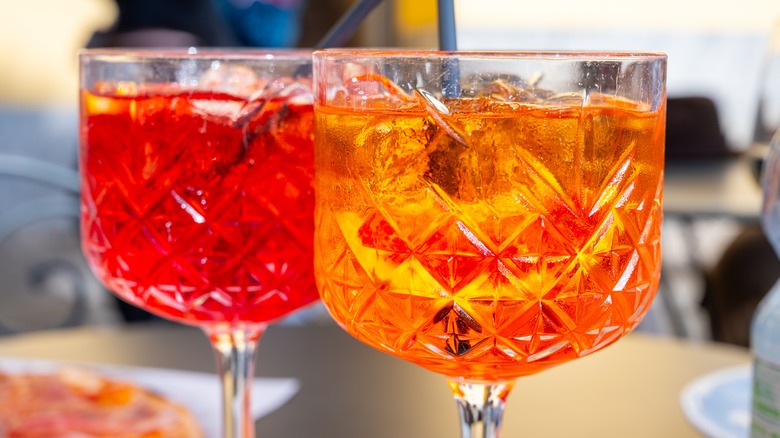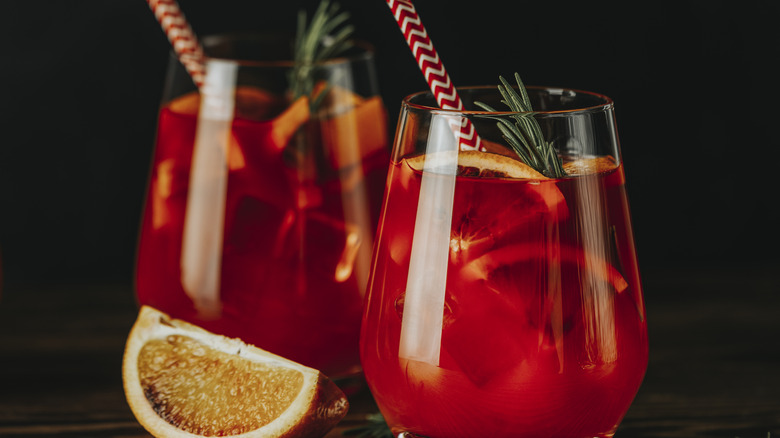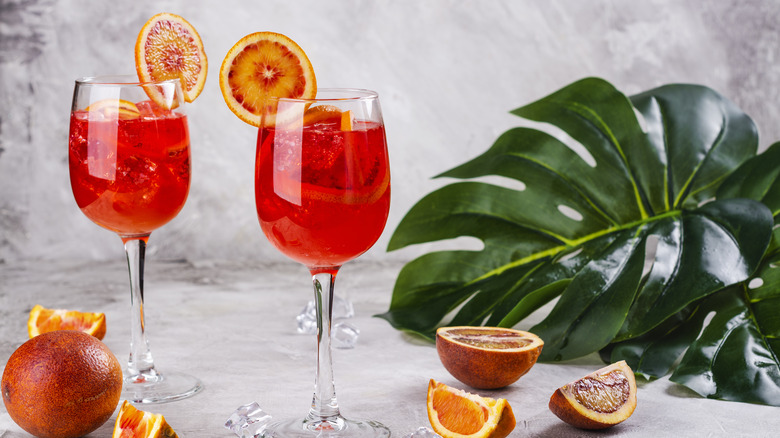Aperol Spritz Vs Bicicletta: The Difference Between The 2 Drinks
With the rate at which Italian-style aperitivo drinks have been taking over the world (and the internet), it's no surprise that some imbibers have been doing a deeper dive into the country's cocktail canon. While the Aperol spritz and Negroni cocktail seem to have the current claim to aperitivo-hour supremacy, there's a strong case to be made for adding the refreshing bicicletta to your menu.
Although, at a glance, the Aperol spritz and bicicletta may seem very similar (they share the same core ingredients: wine, club soda, and a bitter liqueur, all served over ice), two key differences set them apart. In the former drink, you're using the namesake Aperol, along with Prosecco (or another sparkling wine in a pinch). In the case of the bicicletta, the bitter element is Aperol's crimson cousin, Campari, and instead of the bubbly Prosecco, it calls for a dry white wine. These subtle differences may not seem like much in the grand scheme of things when crafting a cocktail, but they result in deliciously unique drinks.
How these differences effect your drink
Much has been made of the differences between Aperol and Campari (beyond their distinctive colors: orange and red, respectively). Aperol is on the sweeter side of the two, while Campari has more of a bitter edge that calls to mind grapefruit and citrus peels, so by extension, your bicicletta will have more of a bite.
When it comes to the wine component, bicicletta recipes may suggest a Pinot Grigio, Sauvignon Blanc, or simply a "dry" white wine — preferably Italian. The Prosecco in a spritz can come in a range of sweetness levels and also be quite dry depending on your selection, so it's possible that the vinous ingredients in both cocktails can bring a similar flavor profile to the table. The big difference, however, lies in the bubbles. Both drinks have a fizzy quality thanks to club soda, but an Aperol spritz will be slightly more effervescent thanks to Prosecco's sparkling nature.
Since higher carbonation can potentially emphasize bitterness, it makes sense that the bicicletta — already more bitter — would benefit from the gentler still white wine. The bottom line is that your bicicletta will be less sweet than an Aperol spritz, with a softer carbonation level and more of a pronounced and pleasant bitterness overall.
Making a bicicletta at home
The bicicletta allegedly gets its quirky name from the two-wheeled transportation method Milanese men used to get home after a few of these cocktails. Today, you can also make this drink in the comfort of your own home.
The beauty of the spritz is, in part, its simple formula, which is adaptable and very forgiving based on your preferences. The bicicletta is no different in that respect. Some recipes suggest a 2:1 ratio (wine to Campari), while others call for 1:1, in either case with a top-up of club soda to taste. Some recipes suggest equal parts for all three elements: wine, Campari, and club soda. The one you choose will have to do with the bitterness balance you wish to strike.
Like the spritz, the bicicletta is a great starting recipe on which to riff. Try another producer of red bitter, like Brooklyn's St. Agrestis Inferno or Cappelletti, for slightly different flavor profiles. Flavored seltzer can substitute club soda, and options like cherry or lemon are a nice complement to the cocktail. You can serve your bicicletta in a wine glass just like a spritz, use a highball, or even a rocks glass. Add an extra garnish like fresh rosemary for a pop of color as well as aromatics. Aperitivo is already an enviable Italian ritual, but knowing that these subtle differences make for a totally unique drink, you can easily add the bicicletta to your offerings.


